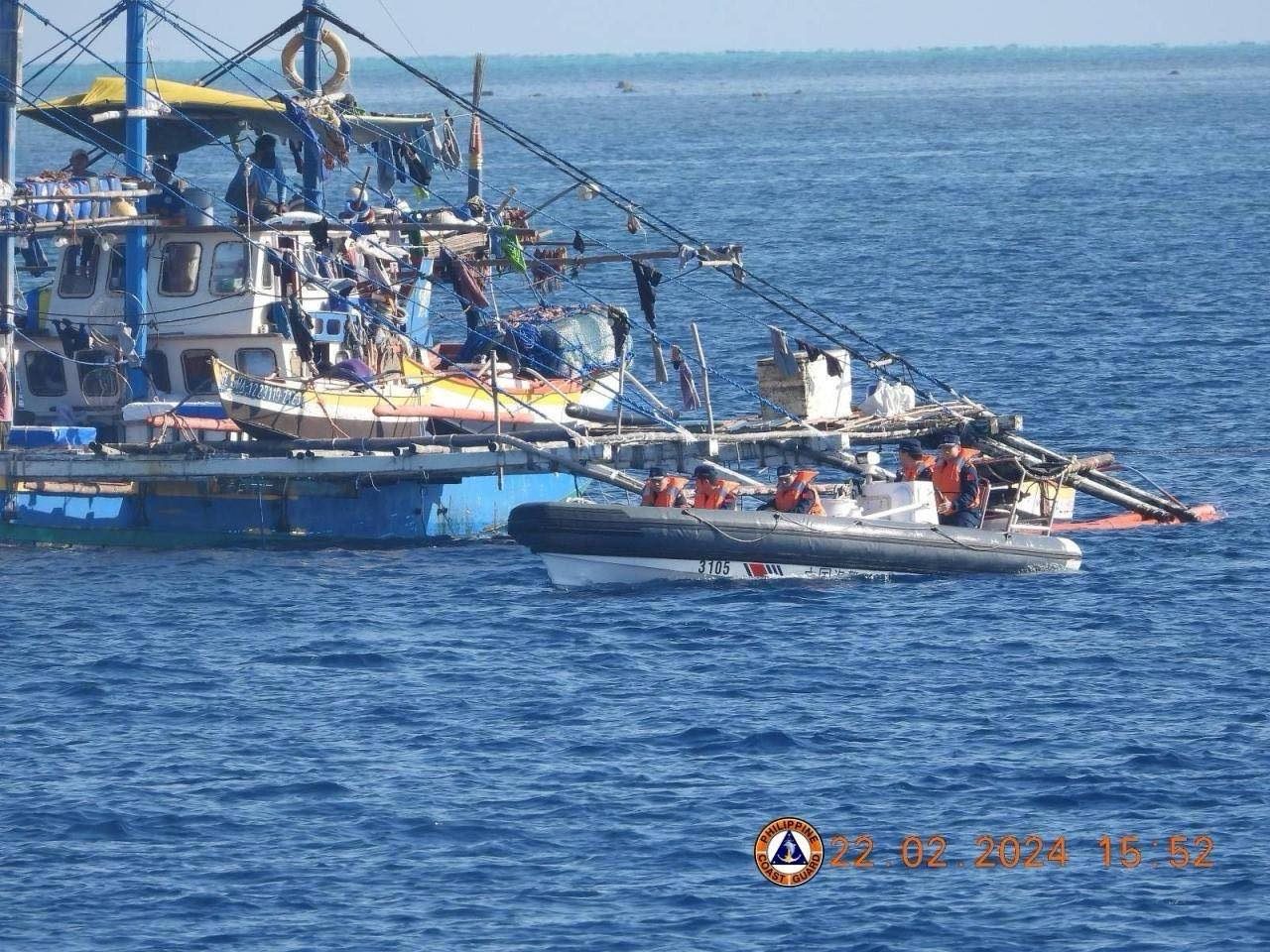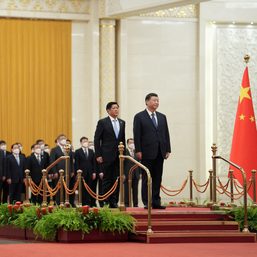SUMMARY
This is AI generated summarization, which may have errors. For context, always refer to the full article.

MANILA, Philippines – Shadowing and blocking maneuvers by China in the West Philippine Sea are nothing new for personnel of the Philippine Coast Guard (PCG), nor for Philippine journalists who are practically regulars in missions to those waters as part of the government’s “transparency initiative.”
But what is new in February 2024 is where those maneuvers are taking place: in Bajo de Masinloc or Scarborough Shoal, a feature over 100 nautical miles off the coast of Zambales that’s also the new focus of the much spoken-about initiative.
On February 22, and again on the 23rd, the Bureau of Fisheries and Aquatic Resources (BFAR) ship BRP Datu Sanday entered the shoal’s territorial sea for a rotational deployment alongside the PCG. During these missions, the BFAR distributes to Filipino fisherfolk in the area essentials to survive longer time out at sea: groceries, supplies, and, most crucially, fuel.
In a release on February 25, the PCG said they monitored at least three shadowing incidents and four “dangerous maneuvers” or blocking incidents by the China Coast Guard (CCG) and Chinese Maritime Militia vessels.
“Blocking” by Chinese ships happens when a ship or several ships – up to three at a time on February 22 – sail across a Philippine vessel’s path. When more than one ship is involved in this at-sea shenanigan, two or three Chinese boats surround a Philippine ship, forcing it to stop in its tracks.
These “gray zone” tactics are often used in Ayungin Shoal during resupply missions to the military outpost BRP Sierra Madre. Now, it seems, China has finally gotten the memo – “transparency” is now the policy in Bajo de Masinloc, too.
In a tweet on February 24, a day before the PCG released videos and photos to show proof of Chinese harassment in the shoal, China’s state-run Global Times said in a post on X (formerly Twitter): “Photos released by the China Coast Guard (CCG) on Saturday show that several journalists were onboard the Philippine vessel 3002 near China’s Huangyan Island on Thursday to take pictures and shoot videos in an attempt to smear and hype the CCG’s operation.”
The post included a grainy photo of at least two cameramen, one photographer, and what looked to be two PCG personnel with cameras on board the BFAR ship. Another less zoomed in photo showed several people, including cameramen and a reporter right outside the deck of the ship.
Embedding is certainly a welcome opportunity for Philippine journalists – in the past, it had not been easy (or possible) to access parts of the West Philippine Sea, much more government-led operations in those waters. The only downside is that your movements are dictated – but not restricted – by government plans and schedules.
The PCG certainly tries to accommodate media requests. A summary of the February 22 mission to Bajo de Masinloc that was released to the media indicates that rubber boats were deployed first so BFAR personnel could document what the CCG was doing in the shoal, and then so Philippine news crews could interview the fisherfolk near the shoal.
I’ve yet to join a mission to Bajo de Masinloc, but I was able to join the November 2023 resupply mission to Ayungin Shoal. While that mission was a huge success – it was the closest the PCG had ever come to the BRP Sierra Madre in a long time – it was still as tense as it could get.
“Thrilling” is not the word to describe the experience of being embedded on a PCG ship during these missions. “Tense” does not suffice either. I’ve settled with “overwhelmed.”
Overwhelming is really the only word that comes close to the experience of being surrounded by CCG and Chinese Maritime Militia (CMM) ships in the West Philippine Sea, and then spotting the rusty but glorious BRP Sierra Madre in a span of just a few hours. I’d admit, however, that certain moments in the mission felt more nakalulula (dizzying) or makalipong (nauseating) – both metaphorically and literally.
It’s interesting that in the first prominent media embed in Bajo de Masinloc, the CCG is quite to react – and oh so dramatically. In their eyes, Philippine journalists are there to “attempt to smear and hype the CCG’s operation.”
Just as interesting and concerning is a new assertion by the PCG: that China seems to be blocking the BFAR ship’s automatic identification system (AIS) signal.
“We noticed that even if our AIS are turned on, there are instances that our vessels cannot transmit their AIS signal. We also noticed this occurrence during the last deployment of BRP Teresa Magbanua and BRP Datu Tamblot,” said PCG spokesperson for the West Philippine Sea Commodore Jay Tarriela.
“We assume that they do the jamming every time they release their statements that they repelled our vessels. Through such jamming, any commercial AIS monitoring cannot also disprove such statements because they may not be able to find our vessels,” he added.
The PCG did not provide proof of the suspected jamming, as of posting.
The AIS is a system through which other ships find out what other vessels are in an area (aside from physical tracking, of course). Chinese ships – the CCG, and CMM – have been known to “go dark” in parts of the West Philippine Sea, which means they’ve turned off their AIS signals.
The PCG also monitored gray ships – or vessels of the Chinese Navy – during the mission. But Tarriela was also quick to note that they were far from the shoal and “did not approach the territorial sea limits.”
Bajo de Masinloc is a high-tide elevation that’s well within the Philippines’ 200-nautical-mile exclusive economic zone. Since bits of the shoal are visible even during high tide, it generates a territorial sea of its own.
China claims almost all of the South China Sea, including the shoal, as its own – even if a 2016 arbitral ruling said their claim was wrong.
Upping military presence in the North
The Philippine Air Force is also making (more) public its efforts to monitor other parts of the Philippines’ coast. In a February 26 release, the PAF said it provided aerial support during the Northern Luzon Command’s Maritime Air Patrol in the Nothern Luzon Seaboard.
“Executing the mission with a C-295 aircraft, the PAF covered key areas, including Itbayat, Sabtang, and Babuyan Islands. No significant activities or sightings were reported during the monitoring of these areas,” said the PAF in a statement.
The statement comes weeks after Defense Secretary Gibo Teodoro ordered the military to boost its presence in the northernmost islands of the country that face Taiwan.
Joint fly upsets China, too
Washington DC and Manila are most definitely serious about upping their defense ties. In the third week of February 2024, their air forces held a joint patrol as a continuation of the third Maritime Cooperative Activity (MCA) that started earlier in the month.
As the cliche goes, the activity is likely to upset Beijing. And upset, China was. Its military said the Philippines was “stirring up trouble” by engaging in joint air patrols with “extraterritorial countries” then “hyping it up.”
Beijing’s assertions prompted National Security Adviser Eduardo Año to speak up. He said in a February 21 statement: “The Philippines rejects China’s assertion that joint patrols with US forces in the West Philippine Sea constitute stirring up trouble. Our engagements with the United States are well within our rights as a sovereign and independent nation, aimed at promoting maritime security and upholding international law.”
He added: “The joint air patrol with the US is part of our longstanding defense cooperation. We will continue to work closely with our friends, allies, and partners to ensure a secure and prosperous future for all nations in the Indo-Pacific region.”
By the way things are going, it wouldn’t be surprising to see another MCA in March. – Rappler.com
1 comment
How does this make you feel?






![[Just Saying] SONA 2024: Some disturbing points](https://www.rappler.com/tachyon/2024/07/TL-marcos-sona-points-july-23-2024.jpg?resize=257%2C257&crop=335px%2C0px%2C720px%2C720px)

This is psychological and media warfare between Communist China and our country. I hope that this will not escalate to the use of force. Or is it just a matter of time?